July 31, 2008
When Blogs and Stained Glass collide
This blog entry called When Geeks and Stained Glass Collide has generated some buzz in the blogosphere in the past few days. It's interesting if only to see that there are people out there looking for non-photoshopped unusual stained glass. Also interesting to see the Gerhard Richter Cologne Cathedral window lumped in with a stained glass depiction of Spiderman.
July 30, 2008
The Nature of Glass Disputed
Kenneth Chang of the New York Times has an interesting article about disagreements in the scientific community about the Nature of Glass. I can't say I'm able to follow much of it, but it is still a fun read with terms like 'ideal glass' and 'dynamical heterogeneity'.
And do also check out the rather curious tale of Buzz Aldrin's Flashlight.
July 27, 2008
What It Is
Speaking of drawing - another item promoting the preservation of the practice of hand drawing - Lynda Barry's new book, What It Is.
It is part autobiography and part creative manual, but the heart and literal center of the book - the part I like best - is the short graphic essay called "The Two Questions", which deals in general with why children abandon drawing as they grow older.
I agree with the conclusion - to all the kids who quit drawing... come back!
July 26, 2008
Secret of Drawing revisited
I mentioned in a previous post about a series on the BBC called The Secret of Drawing. I've now come across full length videos for 3 of the 4 episodes, on Google Video, plus one on YouTube. I'm embedding one part of part one, and linking to the Google videos -
Each episode is approx. 55 minutes long -
Episode 1 - The Line of Enquiry - website info, video is now available on YouTube in 6 parts - part 1.
Introduction to the series - The program presents drawing as utilitarian and observational drawings, going from scientific, anatomical, and nature drawing to Turner's abstracted observations of nature and Constable's landscapes.
Epeisode 1 - The Line of Enquiry, part 1 of 6 - embedded
Episode 2 - Storylines - website info, Google video.
It's nice to see otherwise lowbrow arts like Comic Books, Graphic novels, Japanese Manga, Storyboard Art, and Film Animation be covered as drawing, and therefore as legitimate 'Art'. Still, the show's perspective is a bit too much reliant on the 'artist as lone genius' perspective on creating art. For instance, in the segment on Comics, the emphasis is solely on the lone comics creator, in this case on Daniel Clowes. There is no mention of comics made in the more common commercial manner - made by multiple artists with one person writing, a different person doing the composition in pencil, another drawing in the lettering, another inking over the pencil lines. Several different hands drawing to create a whole work of art. Similarly, and more amazingly, there is little mention of the number of hands required to make an animated film. There is only the emphasis on the lone animator again.
Episode 3 - All in the Mind - website info, Google video.
Basically set around the idea of 'Why do people draw?" Going from cave paintings to outsider artists. The compulsion to depict the world, real or imagined, in drawn form. Is it for the artist or the audience, or both?
Episode 4 - Drawing By Design - website info, Google video.
Focusing on drawing as purely to be realized in other media. Architectural drawings, drawings for rock concert and theater set designs. The most interesting part of this is where he distinguishes between practical architectural design and architectural fantasy drawing.
In general, the series is as interesting for what it does not feature as much as for what it does. Still, it is rare to see any kind of emphasis put on drawing, and I like it. No mention of drawing for stained glass, of course, but many of the ideas are relevant, especially in this last episode. I like the idea of applying architectural fantasy drawing to stained glass. That is, I'd like to see a variety of artists create stained glass fantasy commissions in drawn form.
July 22, 2008
The Angels and Devils of Fairford
Recent postings on the Stained Glass Network email discussion forum have reminded me of a place I've always wanted to go - Church of St. Mary, Fairford, Gloucestershire, UK.
Though I've never visited the church itself, I've seen much of the glass though books and the web over the past 25 years, and the stained glass here is amongst my favorites. Amazing compositions and even more amazing details.
The most famous and most reproduced image from St. Mary's -
from The Last Judgement Window

I probably first saw this image in the book Stained Glass, by Lawrence Lee et al, the well illustrated, oversized and always useful book published by Crown publishers and amazingly cheap as a used book on Amazon these days.
Best web source for St. Mary's images and info - photo gallery at sacred-destinations.com.
A quick scattershot of other images from a small selection of windows
below the fold...
Last Judgement Window
The most famous of the old windows - The West Window.
full image from Flickrite robin.croft
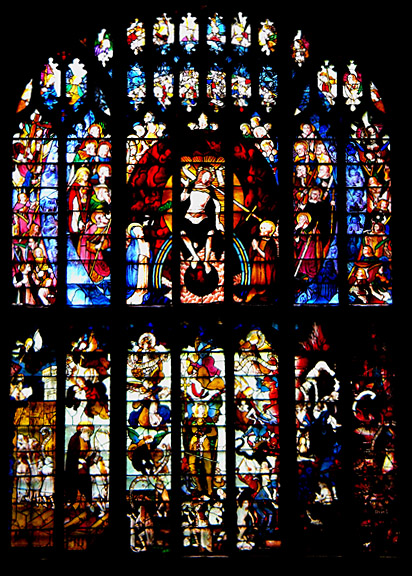

closer in, lower right - the famous image of Satan as Monster
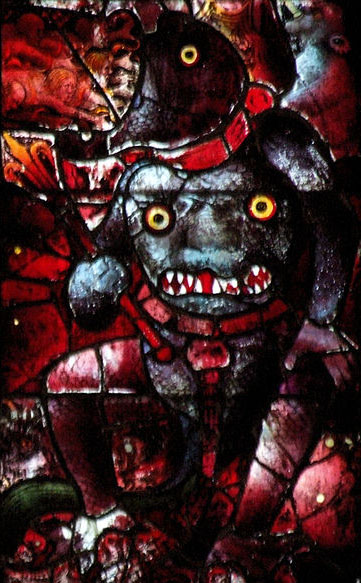
I've long been fascinated by this face in the torso of Satan - is this a depiction of decorated armor or does this image have anything to do with the Blemmyes, the medieval notion of a race of men with no head and a face in their torso.
Persecutors with Devils
Devils in the upper light of Window 27,
which has portraits of murderers and persecutors of the faith.
the window in full with the devils in the upper lights


Image from the Devils page by Flickrite 'Robin.Croft'
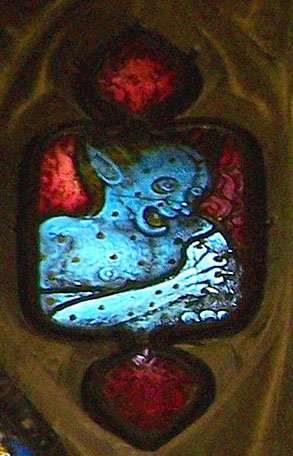
Angel Choir
From a set of Angel Choir figures of Fairford, also by Flickriste robin.croft

The Judgement of Solomon
Another West Window - even in the less famous images, there is something interesting - in this case, the visual art equivalent of breaking the fourth wall.



Resurrection Morning
In the east end of the Corpus Christi Chapel.
Again, I like these odd compositions with their shifting and disjointed perspectives.


July 18, 2008
St. Louis City-Wide Open Studios 2008
FYI - I will be participating this Saturday in the 3rd Annual St. Louis City-Wide Open Studios.
If you are going, get a map, preferably the real printed map - you can pick one up at the Contemporary Art Museum in St. Louis. You can also download a pdf map on this page - unfortunately, it's so big you can't print on any conventional printer. Finally, you might also try the rather interesting Google Map STL Open Studio page, where you can browse the different individual locations in Google maps.
July 16, 2008
Blogging the SGAA Conference 2008
Elizabeth Steinebach from the Canadian-based organization Artists in Stained Glass gives an account of her time at the SGAA 2008 Conference in Oakland CA. -
Pre-Conference Class Day
Official Opening Day
Saturday Report
Sunday report
Interesting stuff, especially seeing that I was intrigued by the prescence of distinctly non-SGAA type artists like Paul Marioni, Dick Weiss and Cappy Thompson. I only wish more people did this type of conference blogging. Multiple perspectives would help enormously...
July 11, 2008
The Medieval Bestiary
Surprised I haven't stumbled on this before - The Medieval Bestiary - Animals in the Middle Ages. Looks like a great site for reference material. Just a quick look so far, but the galleries look very good, if a bit confusing to navigate.
On top of that, the site also hosts Chimera, the Bestiary Blog, which led me to Per Omnia Saecula - Adventures in Medievalism, a medievalist blog which has a slew of links to other medievalist websites and blogs. This could take days to fully explore. I love it when I hit a new vein of interesting and useful information on the internet...
July 07, 2008
Frédéric Back
I've known of the animation of Frédéric Back for more than 25 years, so I was surprised when I found out he did stained glass.
I was doing a search on Flickr (for 'stained glass metro') and found this image of the Montreal Place-des-Arts Metro Station Mural. The Frédéric Back Glass Mural was the first commission for the Metro system, completed in 1967, and has a theme centered on the history of music in Montreal.
Make sure to check out the Frédéric Back website which is one of the most amazingly comprehensive websites for any living artist I've ever seen. I wasn't expecting to see anything beyond the animation, but his stained glass work is well represented. There is even a section devoted to his role in environmental activism.
Image from wikipedia entry for the Place-des-Arts commission

Detail - image from Flickrite marjolabiche
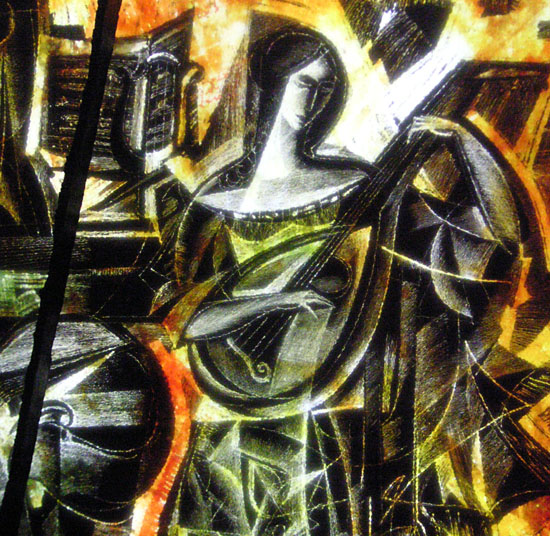
Detail - from the Montreal Metro Art Commission page -
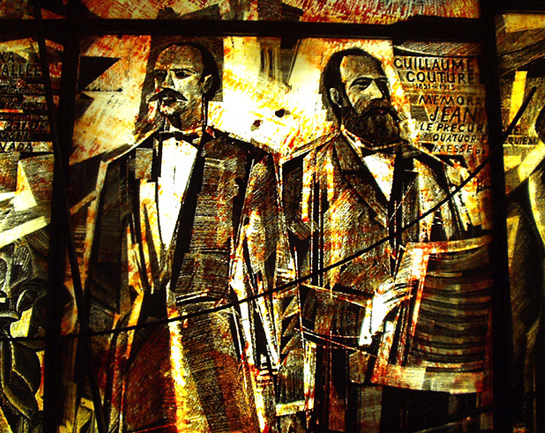
Again, Frédéric Back is best known for his animated films, the best known of those being The Man Who Planted Trees (in full at lower resolution on Google video here)
Personally, I still think I like Crac even better. On top of that, it has a musical theme, just like the stained glass - just enjoy...